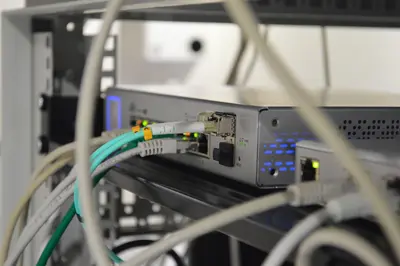Setting Up Static IP Address in Alpine Linux: Complete Network Configuration Guide
I’ll show you how to set up a static IP address in Alpine Linux. This is essential for servers, network appliances, or any system that needs a fixed network address.
Introduction
Setting up a static IP might seem intimidating, but it’s actually pretty straightforward once you know the right files to edit. I do this all the time for servers that need consistent network addresses.
The main reason you’d want a static IP is for services that other machines need to reach reliably. DHCP can change your IP address, which breaks things like SSH connections, web servers, or database access.
Why You Need This
- Ensure servers have consistent network addresses
- Set up services that other machines access
- Create reliable network configurations
- Avoid DHCP conflicts and address changes
Prerequisites
You’ll need these things first:
- Root access to Alpine Linux system
- Basic knowledge of your network setup
- Network interface name (usually eth0)
- IP address range from your network administrator
- Gateway and DNS server addresses
Step 1: Check Current Network Configuration
Identifying Network Interface
I’ll start by checking what network interfaces you have and their current settings.
What we’re doing: Finding network interface names and current IP configuration.
# List all network interfaces
ip addr show
# Check current routing table
ip route show
# Display network interface status
ifconfig -aCode explanation:
ip addr show: Lists all network interfaces with their current IP addressesip route show: Shows current routing table and default gatewayifconfig -a: Alternative way to view network interface configuration
Expected Output:
1: lo: <LOOPBACK,UP,LOWER_UP> mtu 65536
inet 127.0.0.1/8 scope host lo
2: eth0: <BROADCAST,MULTICAST,UP,LOWER_UP> mtu 1500
inet 192.168.1.100/24 brd 192.168.1.255 scope global eth0What this means: You have a loopback interface (lo) and ethernet interface (eth0) with current IP 192.168.1.100.
Checking Current Network Settings
What we’re doing: Understanding your current network configuration before making changes.
# Check current network configuration
cat /etc/network/interfaces
# Look at current hostname
hostname
# Check DNS settings
cat /etc/resolv.confCode explanation:
/etc/network/interfaces: Main network configuration filehostname: Shows current system hostname/etc/resolv.conf: Contains DNS server configuration
Step 2: Configure Static IP Address
Editing Network Interfaces File
What we’re doing: Configuring the main network interface with static IP settings.
# Backup current configuration
sudo cp /etc/network/interfaces /etc/network/interfaces.backup
# Edit network configuration
sudo nano /etc/network/interfacesConfiguration example:
Before (DHCP configuration):
auto lo
iface lo inet loopback
auto eth0
iface eth0 inet dhcpAfter (Static IP configuration):
auto lo
iface lo inet loopback
auto eth0
iface eth0 inet static
address 192.168.1.50
netmask 255.255.255.0
gateway 192.168.1.1
dns-nameservers 8.8.8.8 8.8.4.4
dns-domain example.comConfiguration explanation:
auto eth0: Brings up interface automatically at bootiface eth0 inet static: Sets interface to use static IP instead of DHCPaddress 192.168.1.50: Your chosen static IP addressnetmask 255.255.255.0: Subnet mask (adjust for your network)gateway 192.168.1.1: Router IP address for internet accessdns-nameservers: DNS servers for domain name resolution
Tip: Always choose an IP address outside your DHCP range to avoid conflicts.
Alternative Configuration Methods
What we’re doing: Using Alpine’s setup tools for network configuration.
# Use Alpine's network setup tool
sudo setup-interfaces
# Or configure manually with ip commands for testing
sudo ip addr add 192.168.1.50/24 dev eth0
sudo ip route add default via 192.168.1.1Code explanation:
setup-interfaces: Interactive Alpine tool for network configurationip addr add: Temporarily adds IP address for testingip route add default: Sets default gateway temporarily
Step 3: Configure DNS Resolution
Setting Up DNS Servers
What we’re doing: Configuring DNS servers so your system can resolve domain names.
# Edit DNS configuration
sudo nano /etc/resolv.confDNS Configuration:
# Primary and secondary DNS servers
nameserver 8.8.8.8
nameserver 8.8.4.4
# Search domain for short hostnames
search example.com
# Domain name for this host
domain example.comDNS explanation:
nameserver 8.8.8.8: Google’s primary DNS servernameserver 8.8.4.4: Google’s secondary DNS serversearch example.com: Domain to append to short hostnamesdomain example.com: Default domain for this system
Making DNS Configuration Persistent
What we’re doing: Ensuring DNS settings survive reboots and network changes.
# Install openresolv for persistent DNS
sudo apk add openresolv
# Create persistent DNS configuration
echo 'name_servers="8.8.8.8 8.8.4.4"' | sudo tee /etc/conf.d/net
# Update configuration
sudo resolvconf -uCode explanation:
openresolv: Package that manages DNS configuration/etc/conf.d/net: Persistent network configurationresolvconf -u: Updates DNS configuration from settings
Step 4: Apply Network Configuration
Restarting Network Services
What we’re doing: Applying the new network configuration and verifying it works.
# Stop network interface
sudo ifdown eth0
# Start network interface with new configuration
sudo ifup eth0
# Alternative: restart networking service
sudo service networking restartCode explanation:
ifdown eth0: Shuts down the network interfaceifup eth0: Brings up interface with new configurationservice networking restart: Restarts entire networking subsystem
Expected Output:
SIOCGIFFLAGS: No such device
SIOCSIFADDR: No such deviceDon’t worry about these messages - they’re normal during interface restart.
Verifying Configuration
What we’re doing: Testing that the static IP configuration is working properly.
# Check new IP address
ip addr show eth0
# Test connectivity to gateway
ping -c 3 192.168.1.1
# Test DNS resolution
nslookup google.com
# Check routing table
ip route showCode explanation:
ip addr show eth0: Shows IP configuration for specific interfaceping -c 3: Tests connectivity with 3 ping packetsnslookup: Tests DNS resolution capabilityip route show: Verifies routing table includes default gateway
Practical Examples
Example 1: Home Network Setup
What we’re doing: Configuring static IP for a home server on typical home network.
# Typical home network configuration
cat > /etc/network/interfaces <<EOF
auto lo
iface lo inet loopback
auto eth0
iface eth0 inet static
address 192.168.1.100
netmask 255.255.255.0
gateway 192.168.1.1
dns-nameservers 192.168.1.1 8.8.8.8
EOF
# Restart networking
sudo service networking restartCode explanation:
192.168.1.100: Static IP in common home network rangegateway 192.168.1.1: Typical home router addressdns-nameservers 192.168.1.1 8.8.8.8: Use router DNS first, then Google
Example 2: Enterprise Network Configuration
What we’re doing: Setting up static IP for enterprise environment with specific requirements.
# Enterprise network with VLAN configuration
cat > /etc/network/interfaces <<EOF
auto lo
iface lo inet loopback
auto eth0
iface eth0 inet static
address 10.0.10.50
netmask 255.255.252.0
gateway 10.0.8.1
dns-nameservers 10.0.1.10 10.0.1.11
dns-search company.local
dns-domain company.local
EOF
# Apply configuration
sudo ifdown eth0 && sudo ifup eth0Code explanation:
10.0.10.50: IP in enterprise private range255.255.252.0: Larger subnet mask for bigger networksdns-search company.local: Corporate domain for hostname resolution
Troubleshooting
Network Interface Not Coming Up
Problem: Interface fails to start with static configuration Solution: Check configuration syntax and network hardware
# Check interface status
sudo ifconfig eth0 up
# Look for error messages
dmesg | grep eth0
# Verify cable connection
ethtool eth0 | grep "Link detected"Cannot Reach Gateway
Problem: Static IP set but no internet connectivity Solution: Verify gateway address and routing
# Test gateway connectivity
ping 192.168.1.1
# Check if gateway is correct
ip route show | grep default
# Temporarily add correct route
sudo ip route add default via 192.168.1.1DNS Resolution Failed
Problem: IP connectivity works but domain names don’t resolve Solution: Fix DNS configuration
# Test DNS directly
nslookup google.com 8.8.8.8
# Check current DNS settings
cat /etc/resolv.conf
# Manually set DNS for testing
echo "nameserver 8.8.8.8" | sudo tee /etc/resolv.confBest Practices
-
Always Backup Configuration:
# Backup before changes sudo cp /etc/network/interfaces /etc/network/interfaces.$(date +%Y%m%d) -
Choose IP Outside DHCP Range:
- Most routers use 192.168.1.100-200 for DHCP
- Use addresses like 192.168.1.50 for static IPs
-
Document Your Network Settings:
- Keep record of assigned static IPs
- Note which services use which addresses
Verification
To verify the static IP configuration:
# Check assigned IP address
hostname -I
# Verify routing works
traceroute google.com
# Test DNS resolution
host google.com
# Check network connectivity
curl -I https://google.comExpected Output:
192.168.1.50
PING google.com (172.217.12.110): 56 data bytes
64 bytes from 172.217.12.110: seq=0 ttl=117 time=15.2 msWrapping Up
You just learned how to:
- Configure static IP addresses in Alpine Linux
- Set up DNS resolution for domain names
- Apply and verify network configuration changes
- Troubleshoot common network connectivity issues
That’s it! You now know how to set up reliable static IP addresses in Alpine Linux. This gives you consistent network addresses for servers and services. I use this setup for all my Alpine Linux servers that need fixed network identities.




